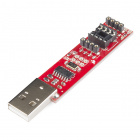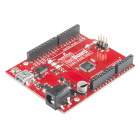Electronic E-craft Terrarium
Introduction
Introduction
People put plants (both plastic and real) in terrariums to create small, concentrated natural environments. What makes these terrariums interesting to me is that the glass enclosure isolates the ordinary objects from the real world and frames the objects for people to take a closer look. For this project, I included electronic components into a terrarium for people to appreciate the aesthetic aspects of technology. Also, I also wanted to express that technology is alive in another way.
In this tutorial, I will be creating an interactive, electronic terrarium. When the edge of the terrarium is touched, the lights start to breathe, and a leaf appears in the sand. To see the terrarium in action, check out the video below.
ReplaceMeOpen
ReplaceMeClose
Materials Required
You will need the following materials to follow along with this project.
You will need one of the following to program the ATtiny.
Additionally, you will need the following materials:
- An ATtiny Microcontroller - This project uses the ATtiny45. You could also use the ATtiny85.
- TIP120 Transistor
- Paint
- Sand
- Fabric
- Crimp Beads
- Glass Vase
Suggested Reading
If you aren't familiar with the following concepts, we recommend reading over them before proceeding.
- Light-Emitting Diodes
- Voltage, Current, Resistance, and Ohm's Law
- How to Solder - Through Hole
- What Is Electricity?

